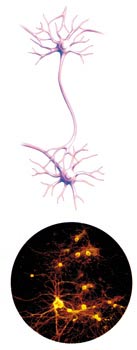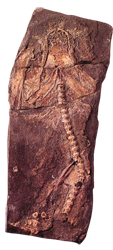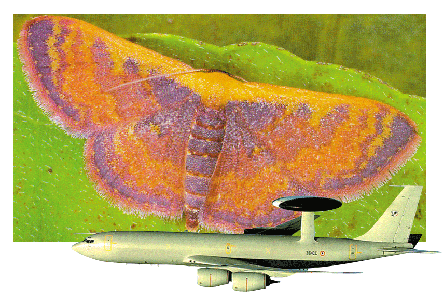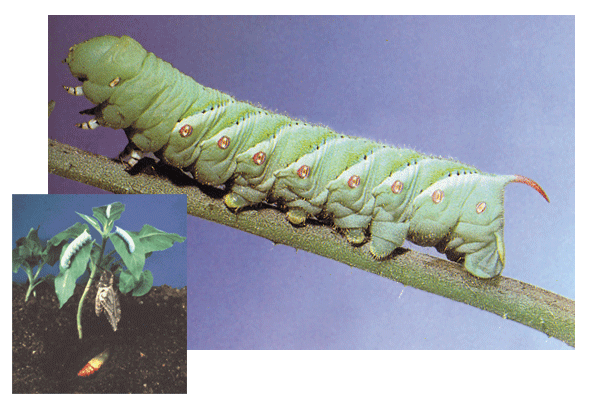Examples of Signs Leading to Faith
One can encounter these signs in any place that is accessible to our five senses. Large or small, living or non-living, every created thing contains a path leading to the Creator, which indicates that there are an infinite number of signs leading to faith. Those believers who wish to be closer to God and be welcomed to a high degree in Paradise must strive to acquire knowledge of these signs, think deeply about them to hone their certainty and reinforce their faith, and live by the moral values that are pleasing to God.
Those who realize the importance of these signs as they read this book will begin to learn and think deeply about them. Therefore, we have devoted some space to just a few of the millions of the proofs of faith to help these readers.
Proofs Of Faith From Our Own Bodies

As you read these words, millions of processes are going on in your body to calculate the needs of specific cells in specific bodily regions, to set out the functions they need to perform, to take the measures necessary to meet the cells' needs, and to tell the cells what to do.
For example, the eye's cells need glucose for nutrition. To that end, a particular bodily system identifies the amount of sugar in your blood and maintains it at the same level. The number of times your heart needs to beat every minute, the levels of the calcium stored in your bones, the amount of blood filtered every minute by your kidneys, and thousands of similar details are all calculated and organized with careful planning and thanks to the communication network among the cells.
Just one bodily system is responsible for all of this: the hormone system, a chemical communication system that allows the body's 100 trillion cells to work in harmony. This system enables coordination between the nervous system and the body's cells. If we compare the nervous system to messages sent over the Internet, then the hormone system resembles messages sent by letter; slower, but more effective in the long run. Let's now consider how the hormone system affects the body's growth.
Proportionate Growth
By the age of one, a baby is twice as heavy and twice as tall as when it was born. As the years pass, it continues to gain weight and grow in height with extraordinary speed.29 This miraculous growth takes place thanks to perfect communication among our cells. Our bodies are managed, on our behalf, by a chemical communication system. The system's message bearers (hormones) carry messages backward and forward among the cells. This process keeps us alive.

From a single cell to a human being ...
The Miracle of Growth
The pituitary gland, a small, pink piece of flesh about the size of a chickpea, is connected to the hypothalamus region, located underneath the brain, by a small stalk. This connection allows it to receive instructions directly from the hypothalamus and thus produce the requisite number of hormones and make the necessary bodily adjustments. One of these adjustments is growth.
A person's growth assumes two different forms: an increase in the volume of certain cells, and the division and multiplication of cells. The growth hormone brings about and directs both processes. Secreted by the pituitary gland, this hormone affects all of the body's cells. Every cell understands the message it receives from the pituitary gland. If growth is necessary, it grows; if it needs to divide and multiply, it does so.

People grow in a healthy manner and possess attractive bodies, thanks to the growth hormone. This hormone gives commands to each of the body's cells, telling it how much to grow and where to stop. This harmony between a molecule and the body's cells is just one proof of God's might.
For instance, a new-born baby's heart is about one-sixteenth the size of an adult's,30 even though the total number of cells in both hearts is the same. The growth hormone, which affects the heart cells individually during the growth process, commands every cell to grow to the necessary extent. As the heart grows, it turns into an adult, human heart.
Other cells, such as muscle and bone cells, divide and multiply throughout the developmental period. Again, the growth hormone is responsible for telling them how much they need to divide.31
The growth hormone's great affect on each cell is an exceedingly great miracle. Were only some cells to follow its instructions, the result would be crippling. For example, if the heart cells grew in the manner dictated by the growth hormone and the ribcage's cells refused to do so, the growing heart would be so constricted within the non-growing ribcage that the person would die. Or, if the bridge of the nose grew while the skin did not, the bridge would burst through the skin.
All of the muscles, bones, organs, and the skin grow in harmony with one another. This flawless harmony is ensured by each individual cell's obeying the growth hormone. That being the case, we need to ask how this chick-pea-sized gland comes to know the necessary formula for a cell's division or growth.

At this point, the flawlessness and perfection of God's creation emerges once again. Cells in a tiny region bring about the division and growth of trillions of other cells within a specific order. Yet these cells do not see the human body from the outside or know how much it needs to grow or what stage it has reached. These unconscious cells produce the growth hormone, within the darkness of the body, without knowing what it is that they are doing. Furthermore, they also halt production at the appropriate time.
All of these intricate details about the growth hormone and all of these interconnected balances indicate a single truth: God created humanity at a specific time and in a flawless manner. In fact, God reveals the superior nature of His creation in the following verse:
He is God—the Creator, the Maker, the Giver of Form. To Him belong the Most Beautiful Names. Everything in the heavens and Earth glorifies Him. He is the Almighty, the All-Wise. (Qur'an, 59:24)
Super Regulators: Enzymes
No one can count the number of processes carried out in living things in a single second. They are so detailed that every stage requires the intervention of "super regulators" that can control all of the complexity involved, provide the order in which they take place, and accelerate events. Each of the thousands of super regulators, known as enzymes, serves a specific purpose, such as helping DNA to replicate itself, breaking down foodstuffs, creating energy from food, bringing about molecular chains from simple molecules, and so on. They also maintain the order within a living being's body.
Enzymes are produced by the mitochondria located within the cell. Their larger regions consist of proteins, whereas the rest consist of vitamins and vitamin-like substances. If these enzymes did not exist, the body could not function. At the least, the body's functions would slow down almost to the stopping point. In either case, the person would die due to his or her inability to breathe, eat, digest, or speak. In short, life as we know it would be impossible.
The enzymes' most important task is to initiate, halt, and accelerate various chemical reactions in the body. As the cells carry out their functions, the chemicals within them undergo certain reactions that require the presence of high temperatures to get started. But such high temperatures threaten and even kill cells. This is where enzymes become essential.
Enzymes, which undergo no chemical reactions themselves, initiate or accelerate chemical reactions without the need for high temperatures. For instance, the enzyme that cleans the carbon dioxide from our blood enables us to stay alive without suffocating. Known as "carbonic anhydrase," it speeds up the carbon dioxide cleansing process by 10 million times.32 At this speed, enzymes cause changes in 36 million molecules a minute.33
How Do Enzymes Know What To Do?
Enzymes both accelerate vital reactions to the highest possible speed and also use the body's energy in the most economic manner. If we think of the human body as a factory and of the enzymes as the means of production, no source of energy could meet that factory's needs, for the amount of energy needed for the trillions of machines to work flawlessly would be very high. It follows, therefore, that in order to carry out a simple reaction, a cell needs a high temperature and a considerable amount of energy.
Yet the silently working enzymes fulfill their functions by using the energy they take from the body and its nutriments. This feature alone is sufficient to reveal that these are highly skilled personnel designed to make every reaction flawless and usable. At this very moment, many enzymes are controlling the reactions taking place throughout your body and bringing them up to a speed that allows your cells to stay alive.
Although a person is unaware of what is going on in his body, enzymes are both aware and make the most essential and timely interventions into all these processes. Moreover, every enzyme accelerates specific chemical reactions inside the body without any mistake, for each enzyme has been specially produced for its own task. For example, although many enzymes are effective in neutral liquid environments, those enzymes charged with digesting foodstuffs in the stomach can operate only in acidic environments.

We do many things without really thinking them, such as walking, running, and talking,
thanks to the enzymes created by God.
Why Do Enzymes Only Initiate Specific Reactions?
All enzymes are compatible with the substances that they affect. They locate and adhere to a compatible substance in a most conscious manner, just like a key and a lock, within a complex three-dimensional geometry. Enzymes resemble hunters that, located throughout the body, wait for the appropriate substance. They are all in the correct place, well suited to their own design and properties, and avoid harmful environments or those that will render them ineffective. The way that they assume such responsibilities as initiating or accelerating all reactions requires separate consideration.
In the absence of any obstructive factor, enzymes initiate and accelerate all of the body's reactions. This leads to the excess production of a particular protein, for instance, or to the disruption of various balances inside the cell. Thus, the cell regulates the enzyme's activities by "deciding" that its activities need to be halted and then "distracting" the enzyme with extraordinary consciousness and planning. To do this, it sends a substance similar to that to which the enzyme normally attaches itself and thus prevents unnecessary activity for a certain amount of time. As this imitative substance needs to compete with the real substance to attract the enzyme, this process of obstructing the enzyme is known as "competitive inhibition." As a result, the enzyme's activities are temporarily halted until the product formed is reduced to a specific level.
Such phenomena cannot be glossed over in a single reading. First and foremost, recall that educated, conscious, and responsible human beings do not make the above calculations, take decisions, and put the plans into action; rather, all of this is done by proteins, fats, carbohydrates, and vitamins that consist of inanimate atoms. As if carrying out a stock control, the cell identifies how much of a particular substance it produces and, when it decides that enough has been produced, implements a most intelligent plan to prevent overproduction.
The cell's production of an imitative substance to distract the enzyme and its ability to send it just at the appropriate moment is a most conscious activity, for if these imitative substances were always present, they would hinder production at inappropriate times. However, cells also achieve perfect timing. Such behavior, which requires perfect organization, intelligence, and information, is performed by tiny molecules that are invisible to the naked eye, surely an indication of God's artistry in creation. Clearly, all of these entities act according to His commands.
Tiny Hairs That Allow Cells To Move
Another example of a sign leading to faith is the tiny eyelash-like hairs whose sole function is to allow the cell to move. For example, each cell in each respiratory channel has a hundred of these hairs. By moving in concert all at once, rather like the oars of a ship, these hairs allow the cell to move forward.
- - When cut perpendicularly, a hair is shown to consist of nine separate rods (microchips).
- - These rods, known as micro-tubes, consist of two interconnected links.
- - One of these links consists of 13 separate fibers, and the other of 10.
- - The micro-tubes are produced by a protein known as tubulin.
- - The micro-tubes have two protrusions, the inner and outer arm, which contain a protein called dynein. This protein serves as an engine among the cells and gives rise to a mechanical force.
- - The molecules making up the tubulin are arranged just like bricks and give rise to a cylindrical structure within the cell. However, the arrangement of the tubulin molecules is far more complex than mere bricks.
- - Two more micro-tubes in the middle of the tiny hairs stand alone and consist of 13 tubulin strips.
- - There are 10 short protrusions on the upper side of each tubulin, and 10 indentations on the under side, and both of them fit together in order to form a very solid structure. These protrusions and indentations have a very special design, and the slightest imperfection will damage the cell's structure.
This is a very brief summary of the detail in these tiny hairs. All of these parts belong to a single hair, and their only aim is to cause just one cell to move. Each person's respiratory cells contain this complex system. Moreover, this complex and multipart system is the infrastructure of a tiny hair inside a cell, which is itself too small to be seen with the naked eye.
In short, God has installed an exceedingly systematic and complex mechanism in a space that is too small for us to see. How could chance think about making a cell move, establish such a system, and insert it into such a restricted space? This is only possible due to God's superior and infinite reason, knowledge, and might.

Some cells move thanks to the micro-hairs shown magnified above.
The harmonious movements exhibited by these hairs can be compared to people rowing a boat.
Brain Cells That Function Like Expert Anesthetists

The design in the brain cells is just one of the countless proofs of creation.
Bones are designed to break at their thinnest parts when they encounter high pressure, in order that other bones and organs are not damaged. The body contains a string of precautionary measures for such an occurrence. One of these precautions is the chemical secretion endorphin, which reduces pain during breakage.
The nerves, which are stressed when a bone breaks, send a large number of signals to the brain through the spinal cord. The brain cells then begin to secrete endorphin, a natural anesthetic resembling morphine. This secretion reduces the pain signals to almost zero for the first 10-15 minutes so that the injured person can find enough strength to move away from danger or to take precautionary measures.
How did these cells, all of which are bereft of consciousness, information, hands, eyes, or brains, learn the chemical formula for endorphin? How do they know when to secrete it? Why do they never secrete it at the wrong time? The body carries out a great number of other astonishing and perfect processes built upon an exceedingly finely detailed plan. Only Almighty God could give these unconscious cells the intelligence needed to carry out these functions.
The Body's Flawless Systems Prove God's Might
The nutriment mixture that reaches the intestines after being digested in the stomach contains some rather powerful acids. This acidic environment represents a serious danger to the duodenum, which, unlike the stomach, has no protective layer. That being the case, why is the duodenum not harmed?
When the acid levels reach a dangerous level, the cells in the duodenum's wall secrete a hormone known as secretin. This hormone then mixes with the blood, reaches the pancreas, and stimulates it so that it will send bicarbonate molecules to this region to eliminate the danger. Thanks to these molecules, the stomach acid is neutralized and the duodenum is protected.34
This protective mechanism gives rise to several questions, such as:
- - How do the duodenum cells know that the needed bicarbonate molecules are found in the pancreas?
- - How does the pancreas know the formula for and have the ability to make the bicarbonate molecules to neutralize the acids?
- - How can the pancreas understand the danger signal from the duodenum?
As every rational person knows, cells cannot think, do not possess will power, and cannot take decisions. Therefore, how can they be aware of another organ's features or produce formulae? Clearly, only God, the Lord of the Worlds, creates the cells and their superior properties. With this flawless functioning in their own bodies, God shows people the infinite nature of His might and knowledge.

A 1-gram DNA Molecule Equals 1 Trillion CDs of Data
Engineers designing the computers of the future describe the human genome as an "unachievable" design. Why?
The DNA in the nucleus of every cell in the human body stores all of a person's characteristics. DNA possesses such an unimaginably superior design and data storage capacity that 1 gram of a DNA molecule contains the same amount of data as 1 trillion CDs.35 Bearing in mind that one CD contains as much information as hundreds of books, one can better appreciate DNA's information storage capacity.
The DNA molecule has existed in all human beings and every animal, without exception, since they were first created. This reveals the superior nature of our creation. The fact that all of the data concerning the structure of living things is contained in atoms set out according to a specific code in such a minute space again demonstrates the matchless power and infinite intellect of God, the Creator of all.
Examples of Signs of Faith From Living Things
The Acorn Weevil's Boring Mechanism

A person needs tools to hole in acorn, and yet there is one tiny insect that spends its whole life doing just that without any difficulty. The acorn weevil, which has a tube on its head that is longer than its abdomen, lives on valonia, the woody fruit of an oak tree. At the edge of this tube is a minute but very sharp saw tooth.
In normal times, this insect keeps its tube at the same angle as its body so that it can walk. When it climbs an oak tree, it lowers the tube toward it in order to rest the tube's saw-like edge on the acorn. Moving the tube by turning its head to the left and right, it begins to bore a hole in the acorn. The insect's head, which is ideally designed for this purpose, exhibits an extraordinary freedom of movement.

The acorn weevil knows how it will behave at every stage of its life. As a larva, it does everything it needs to; as an adult, it knows it has to drill a hole in an acorn and make its nest there. God, the Compassionate, gives each insect its unique features.
As the insect conducts its drilling, it also feeds itself by eating the fruit inside the acorn. However, it does not touch the larger part of the fruit, but rather keeps it for its as-yet unborn young. When the drilling process is completed, the insect deposits an egg in the channel opened in the acorn. The egg gradually turns into a larva, which starts to eat the acorn. The more it eats, the more it grows, and the more it grows, the more it eats. Thus, it continues to make enough room for itself within the acorn.
This continues until the acorn falls from the branch. The noise and violent motion it makes as it falls tell the larva that the time has come for it to emerge. Thanks to its strong teeth, it enlarges the hole and emerges through it. The first thing it does after this is to bury itself some 25-30 cm (12 inches) underground. Here, it will undergo the pupa stage and wait for between one and five years. When it emerges as a fully formed adult weevil, it begins drilling acorns. The variation in the pupa stage depends on the maturation of new acorns.36
This insect's interesting life is just one of the proofs that invalidates the theory of evolution and shows the flawless design with which God created living things. Close inspection reveals that all of the insect's mechanisms were constructed according to a specific plan. The drilling tube, the sharp teeth at its end, and the flexible head structure that allows the tube to be used cannot be accounted for by chance or natural selection. If the drilling process were not carried out flawlessly, then the drilling tube would be an impediment, and hence a disadvantage. Therefore, it cannot be claimed that this tool developed in stages.
The larva has to have teeth powerful enough to pierce the acorn's skin, has to "know" that it needs to burrow into the ground the moment it emerges from the acorn, and has to have the "patience" to wait there. Otherwise, it would die and the species would become extinct. These realities cannot be explained in terms of chance, but rather reveal that this tiny creature was created by a superior intelligence. God created this tiny creature, with all of its flawless organs and flawless instincts, because He is "the Maker." (Qur'an, 2:54)
An Interesting Plant: The Bladderwort

The bladderwort uses traps in the shape of sacs for hunting. Exceedingly touch-sensitive hairs are located on these traps (shown above). This plant's special mechanism is just one of the countless signs leading to faith placed in nature by God.
How can a living thing feed itself if it has no legs but is a carnivore? We can find the best answer to this question in the bladderwort plant.
The bladderwort, or Utricularia, is a water plant that has three secretor glands in its sac-like traps. The first of these, the spherical secretor glands, are on the traps' external face, while the other two types (the "four-armed glands" and "two-armed glands") are found on the traps' internal faces. These glands function as the different stages of a most fascinating trap. First of all, the glands on the internal face go into action when their tiny hairs pump water out of the bladderwort, thereby creating a vacuum within the plant.
At its mouth is a valve that prevents any sea water from re-entering. The hairs on this valve are very touch-sensitive. If an insect or another organism in the water touches them, the valve suddenly opens and causes a powerful water current to rush into the empty bladder. The valve then closes before the victim knows what is happening. The whole process takes place in about one-thousandth of a second, and immediately afterwards the glands begin to secrete substances to digest the trapped prey.37
Every bladderwort possesses this same perfect design and the same internal glands, and the hairs on the valves all have the same sensitivity to touch. So how did this mechanism come into being? How did it happen that all members of this species of water plant have exactly the same features?
Evolutionists assert that such features are all the result of coincidence. Yet this design actually points to one single truth: Living things emerged all at once, in full possession of all of their features. Only Almighty God could create all living things as we see them today.
Sharks' Unique Heating Systems
White sharks, which catch their prey by following it with their eyes, experience no difficulty when swimming off hot coral shores. In cold ocean waters, however, their vision should be impaired by the cold.
Under normal conditions, their eyes should find it difficult to follow their prey, since chemical reactions slow them down under the influence of the cold water. Yet white sharks never encounter such difficulties, for while they are cold-blooded, the heat from their body's muscles is directed straight to the eyes. Thus, they can catch the fastest swimming fish and even seals.38
Yet how do other shark species, whose vision is too weak in cold waters to follow their prey, manage to find food? The answer to this question introduces us to the perfect design in sharks.
Sharks are Sensitive to Electrical Currents
All living things give off electricity and heat. Those creatures that live in darkness find it hard to perceive these currents, because the air serves as an insulator. However, water is a natural conductor of electricity, which means that animals that can sense that electricity have a most effective sense perception. Sharks have this advantage to such an extent that they can perceive all vibrations in the water, changes in water temperature and salinity levels, and especially minute changes in electrical currents given off by moving creatures.39
A shark's body contains a large number of gel-filled grooves. These grooves are particularly concentrated at the head, from where they extend right through the animals' bodies. Known as the "ampullae of Lorenzini," these magnificent electrical receivers are used by both sharks and skates to find their prey. These organs are connected to stoma (pores) in the animal's head and snout. As electro-receptors, these are so sensitive that they can perceive currents as small as 20 billionths of a volt.
This is an extraordinary ability. Think of the batteries in your home. Sharks can detect the current given off by one of these 1.5 volt batteries from a distance of 3,000 kilometres (1,800 miles).40
 |  |
| The systems that allow sharks to live in the sea are more signs leading to faith. The fact that both "prehistoric" (right) and contemporary sharks have the same features is yet another sign leading to faith, for this proves that this species emerged suddenly and therefore is not the product of a long process of evolution. This shows that God, the Creator of all living and inanimate entities, created sharks. | |
The information provided so far shows that sharks possess extraordinarily complex bodily systems. Most of their systems and organs function together to such an extent that the others could not function if one were absent. For example, the lack or disablement of even one of the components of this electro-receptor system would mean that the ampullae of Lorenzini could not function as intended.
Despite this manifest truth, the theory of evolution would have us believe that "primitive sharks" did not possess these electro-receptors in the way their modern-day counterparts do, and that this perfect system only developed gradually over time. However, the illogical nature of this assumption is evident, for sharks could not survive without this system. Moreover, such a perfect system could not have developed over time, for the body muscles that transfer heat directly to the eyes, as well as the systems that perceive electrical waves with such extraordinary sensitivity, must have emerged as a whole.
Thus, this system could not have come about in stages, as evolutionists maintain, for the intermediate stages would serve no purpose. The fossil record indeed confirms this: There is absolutely no difference between shark fossils dating back millions of years and present-day specimens.
In addition to the ampullae of Lorenzini, the sharks' respiratory systems, which function as the magnetic receptors that allow them to find their way, and their ability to swim at high speeds are all miracles of creation. As with all other living things, God has created sharks in an absolutely flawless form.
Such facts are all means that encourage people to think deeply about the beauties created by God. There are lessons to be learned from animals, for as the Qur'an states:
Among His signs is the creation of the heavens and Earth and all the creatures He has spread about in them... (Qur'an, 42:29)
A 150-Ton Military Plane Imitates a 2-Gram Moth
Each AWACS plane is designed to establish the moment and direction of an attack before it is launched. These planes, designed by hundreds of scientists and engineers in facilities costing hundreds of millions of dollars, use giant radar and complex computer systems to monitor the activities of enemies located far away. One living thing in nature displays a comparable ability: the moth, which weighs no more than 2-2.5 grams.
Some species of moth are equipped with "early warning" systems, just like those in AWACS planes. Thanks to the ears underneath their wings, they can hear sound waves emitted by bats (their enemies) from as far away as 100 meters (330 feet). This allows them to identify their enemies' coordinates and decide whether an attack aimed at them has been initiated or not.
On the one hand we have an AWACS plane, weighing 150 tons and having a wingspan of 40 meters and a height of 44 meters, and, on the other hand, a moth weighing only a few grams, with a wingspan of 2.5 centimeters and a height of 2 centimeters. Both possess the same technological features. Furthermore, an AWACS plane requires 9.5 tons of fuel, while the moth can make do with a few milligrams of nectar. Kilometers of cable are used for its radar and computer systems, while just two short fibers are enough for a moth's perfect perception system.
These early warning systems, which are the accumulation of centuries of scientific experience and can only be fitted into planes weighing many tons, take place in an area no larger than the head of a match under the wings of a moth weighing only a few grams. Such a miraculous system, which people find very difficult to imitate even by pooling all their resources, has been flawlessly created in a tiny moth. God, the Creator of all, is the Lord and Ruler of the entire universe. Our Lord's name of al-Malik (The Sovereign, The King) is revealed in one verse, as follows:
Exalted be God, the King, the Real. There is no deity but Him, Lord of the Noble Throne. (Qur'an, 23:116)

When the technology in a plane weighing many tons is compared to that in a tiny moth, it is obvious that the moth is a miracle of creation.
A Fly's Ear and Hearing Aids

Hearing aids and a fly
One species of fly, known as Ormia ochracea, lays its larvae on crickets, in which the larvae develop and kill. It is not easy to find a cricket in a forested area. This particular fly, however, is able to do this very easily thanks to its ears, which are specially designed for the purpose.
The human brain uses the same method to determine the direction of sounds. The sound reaches the closer ear first, and then the one that is further away. The brain calculates the time difference between the sound reaching the two ears, and thus identifies the direction from which it came. In human beings, this calculation is performed in 10 milliseconds. The fly Ormia, however, performs the same calculation in a brain no larger than a pinhead 1,000 times faster.41
The designs in nature have always represented an infinite source of inspiration. Many modern technological products actually imitate designs in nature. Obviously, copying systems that have functioned flawlessly for millions of years makes things a great deal easier for designers. For example, attempts are being made to imitate the perfect design in this fly's ear in hearing aids and similar implements, under the name of Ormiaphone. Such designs, which people can only imitate, demonstrate that the power of creation belongs to God alone.
Computer Chip Warming and Butterfly Wings

God creates butterflies with their special cooling systems. Efforts are underway to adapt the same technology to computer chips that overheat.
There is a miracle in the design of a butterfly's wing. A study carried out at Tufts University revealed that each wing contains a special cooling system. Since butterflies are cold-blooded, they have to regulate their body temperature constantly. This represents a major problem, because as they fly, high temperatures develop in their wings. However, this problem is resolved when the blood passes through thin film-like structures in the wings. The surplus heat that forms in the butterfly's body is thus expelled as the blood flows through these delicate vessels.42
This special cooling system, when compared to that in computer chips, was observed to be far more efficient. As computer chip technology develops, the problem of heat worsens. Faster chips mean greater heat. The problem of eliminating this heat is being studied by computer chip manufacturers. They plan to bring the technology in butterflies' wings into production within the next two years.
Scientists model their designs according to what they see in nature. In short, the matchless systems in living things show the way to further technological progress and new solutions.
A New Objective: The Soundless Flight of Owls
The research carried out by American Air Force scientists to develop the stealth bomber airplane is based upon the matchless design found in an owl's wings. Owls can approach their prey at the dead of night without being detected due to the special design of their wings. Other bird species have rather sharp-edged wings; however, an owl's feathers have a very fine—but not at all sharp—design. This allows these nocturnal hunters to fly without making a sound.
According to statements from the NASA's Langley Research Center, an owl's soft-fringed wings prevent air turbulence, which laypeople call noise. Military designers have imitated owl wings in their quest for devising even more silent and secretive stealth bombers.43 Each of these designs is a sign leading to faith, for it reveals the matchless artistry of God's creation.

Attempts are being made to imitate the silent flight of owls in stealth bombers.
Plants That Defend Themselves
Many plant species give off chemical substances when they are attacked by caterpillars. Thanks to these chemicals, insects eating caterpillars are attracted to the area and protect the plants. For instance, the leaves of the tobacco plant that grows in Utah (USA) are attacked frequently by the caterpillar that will later become the Manduca quinquemaculata moth. The wild tobacco plant "analyses" the caterpillar eating its leaves and, "realizing" that it is being damaged, immediately initiates its defense system by giving off air-borne volatile organic compounds. Thanks to these chemicals, the insect Geocoris is attracted to the area and begins to eat the caterpillars.44
In this way, harvest-damaging caterpillars are eliminated by means of an indirect strategy and superior intelligence. However, we need to ask:
 |  |
| Mimosa pudica (sensitive plant) has a very interesting defence system. When the tip of the leaflets of the plant are gently squeezed, within a few seconds they collapse alongside the leaf stalks, and even the stalks themselves eventually droop into a relaxed position. If whatever is troubling the leafy part of the plant persists, it makes a second movement downwards, which exposes the sharp thorns on the stems. This is enough to see insects off. | |
- - How does the plant know that it is being damaged?
- - How does it analyze the caterpillar's saliva and determine from which insect it needs to protect itself?
- - How does it produce the air-borne chemical substance to attract the insect Geocoris to the area?
Of course, no plant can prepare such an intelligent strategy to protect itself. Only God, the Lord of the Worlds Who creates the plants with their flawless properties, can inspire in them what they need to do to protect themselves.

The tobacco plant calls in another insect to rid itself of caterpillars (left) by the Manduca moth (above).
Proofs of God's Existence are Everywhere
As the above examples have shown, the manifestations of God's great might and knowledge over His creation are evident. No unbiased person who reads about the signs leading to faith can claim that these creatures came about by chance or by themselves.
As in these examples, there are additional billions of signs leading to faith, from the sky to plants, from the human cell to the structures so expertly built by animals. Therefore, one comes across these signs everywhere he or she looks. In fact, it would be more accurate to say that we live constantly surrounded by such signs, for God created His servants' bodies, which house many signs, so that we may recall His existence at every moment.
That being the case, all assertions that God does not exist merely reveal those people's heedlessness, which blinds their eyes and clouds their reason, together with the scale of that heedlessness. God reveals the situation of these people, as follows:
Say: "Who provides for you out of heaven and Earth? Who controls hearing and sight? Who brings forth the living from the dead and the dead from the living? Who directs the whole affair?" They will say: "God." Say: "So will you not guard against evil?" That is God, your Lord, the Truth, and what is there after truth except misguidance? So how have you been distracted? (Qur'an, 10:31-32)
No one with an unbiased mind and eyes to see can ever turn his or her back on or deny the proofs of God's existence.
Footnotes
29 James M. Herzog, M.D. and Eleanor Herzog, "Birth To Two." Online at:www.sesameworkshop.org/parents/advice/article.php?contentId=862&.
30 "The Human Heart." Online at: www.toxassociatep.com/heart.htm.
31 Dorothy Starnes, "Growth: Growth is a synthetic process involving the formation of molecules and compounds;" 2002. Online at:http://iaia.essortment.com/growthcells_rmic.htm.
32 Prof. Dr. Engin Gozukara, Biyokimya (Biochemistry), 3d ed. (Istanbul: Nobel Tip Bookstores: 1997), 579-80.
33 "Enzymes." Online at: www.mrothery.co.uk/enzymes/enzymep.htm.
34 "The Human Digestive System." Online at: www.s-cool.co.uk/topic_quicklearn.asp?loc=ql&topic_id=14&quicklearn_id=2&subject_id=3&ebt=&eb.
35 Fenella Saunders, "Gene-ius Computer," Discover 21, no. 4 (April 2000).
36 Mark W. Moffet, "Life in a Nutshell," National Geographic (July 1989): 783-88.
37 Stanley Taylor, "Life Underwater," Botanic, no. 83 (February 1988): 24.
38 John Downer, Supernature, The Unseen Powers of Animals (London: BBC Worldwide Ltd., 1999): 146.
39 Marie-Sophie Germain, Science et Vie, no. 966 (March 1998) 85-89.
40 John Downer, Supernature, The Unseen Powers of Animals, (London: BBC Worldwide Ltd., 1999), 146
41 "Hyperacute Directional Hearing of the Ormia Ochracea Fly," Cornell News/Science Daily. Online at: www.comdig.de/ComDig01-16/# 14.3.
42 "The Butterfly Effect." Online at: www.stephensonstrategies.com/tips/product_marketing_tips/biomimetics_butterfly.html.
43 Robin Meadows, "Designs From Life," Zoogoer (July-August 1999). Online at:http://natzoo.si.edu/Publications/ZooGoer/1999/4/designsfromlife.cfm.
44 Kathryn Brown, "Something to Sniff At: Unbottling Floral Scent," Sciencemag 296:5577 (28 Jun 2002): 2327-29.
